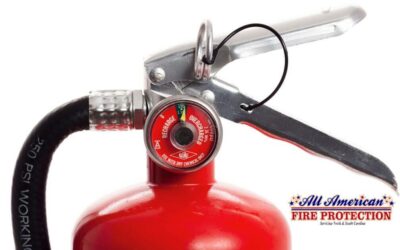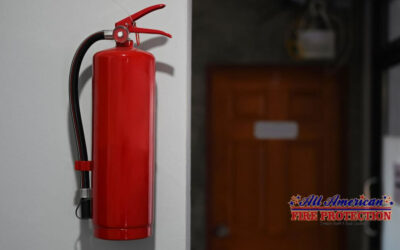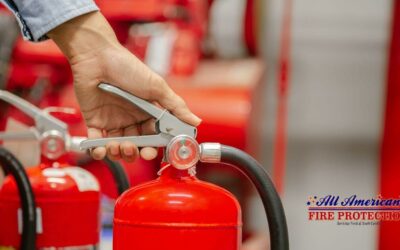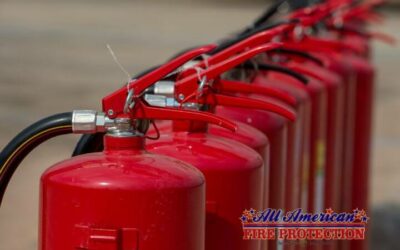Understanding Home Fire Extinguishers
Grasping the essentials of fire extinguishers is a key step in preparing to tackle a blaze within your home. These portable lifesavers emit substances that smother flames, preventing them from growing out of control. All American Fire Protection specializes in providing fire extinguishers, ensuring that households and businesses are equipped with the necessary tools to combat fires effectively and safely.
Fire extinguishers are categorized based on the types of fires they’re equipped to combat. These categories include:
- Class A: This type targets common combustibles like wood, textiles, and paper.
- Class B: Designed to douse fires fueled by flammable liquids such as oils, gasoline, and paints.
- Class C: Suited for electrical fires, where energized equipment is involved.
- Class D: Although typically found in industrial settings, these extinguishers handle fires caused by combustible metals.
- Class K: These are essential in kitchens, as they address fires stemming from cooking oils and fats.
For residential use, a multipurpose extinguisher capable of dealing with Class A, B, and C fires is generally recommended. These often contain dry chemical agents like monoammonium phosphate, which is effective against the most common household fires and is safe for electrical fires.
The size of the extinguisher you choose should reflect both the potential magnitude of a fire in your home and your ability to wield the device. A 5-pound model is often ideal for home use, offering a balance between ease of handling and firefighting power.
Each extinguisher also comes with a numerical rating, indicating the size of fire it can manage. For instance, a rating of 3-A:40-B:C suggests the extinguisher can tackle a sizable Class A or B fire, and any Class C fire once the electrical source is neutralized.
Familiarity with the operation of your fire extinguisher is crucial. Typically, they feature a pin or tamper seal to show they’re ready for use, a lever to activate, a hose or nozzle to direct the agent, and a gauge to monitor pressure levels.
Knowing the location of your extinguisher and how to maintain it, which we’ll explore further, is vital for fire safety. Regular checks and servicing as directed by the manufacturer ensure the device’s functionality in an emergency.
A solid understanding of home fire extinguishers, coupled with ready access and proper upkeep, can significantly enhance your response in a fire situation, potentially safeguarding both lives and property.
Types and Purposes of Home Fire Extinguishers
Delving deeper into the specifics, home fire extinguishers are tailored to address distinct fire classes. Beyond the general classifications, let’s examine the extinguishers best suited for home environments.
- Water Fire Extinguishers: Ideal for Class A fires, these extinguishers cool the burning material. It’s critical to avoid their use on Class B and C fires to prevent spreading the flames or causing electrocution.
- Dry Chemical Extinguishers: These are prevalent in homes, especially those rated ABC, which contain monoammonium phosphate. This agent disrupts the chemical reactions that fuel fires, making it a versatile choice for various domestic fire incidents.
- Carbon Dioxide (CO2) Extinguishers: Best for Class B and C fires, CO2 extinguishers work by displacing oxygen and cooling the fuel. They’re preferred in areas with sensitive electronic equipment, such as computer rooms, as they leave behind no residue.
- Wet Chemical Extinguishers: Primarily for Class K fires, these are increasingly relevant in homes with advanced cooking setups. They produce a foam that cools and separates the fuel from oxygen, effectively quelling kitchen fires.
- Foam Extinguishers: While not as common in residential settings, these are designed for A and B fires, using foam to smother the fire and block flammable vapors.
When choosing a fire extinguisher for your home, consider the specific fire risks in each area. A kitchen may benefit from an ABC extinguisher or a Class K model, while a garage or workshop with flammable liquids might require a larger ABC or CO2 extinguisher.
Striking the right balance between readiness and coverage for various fire types is key. The ease of use and accessibility of your fire extinguisher are also paramount. Each extinguisher includes a manual that is essential to read and comprehend, as it provides detailed instructions and safety guidelines pertinent to your chosen model.
Before Using a Fire Extinguisher
Prior to engaging a fire with an extinguisher, a swift yet thorough evaluation of the scenario is vital. Confirm that the blaze is confined and manageable, such as one that’s contained within a cooking pot or small bin. A rapidly expanding fire, or one that impedes your escape, necessitates immediate evacuation and emergency services notification.
Once you’ve determined the fire’s size is within a controllable limit, ensure the extinguisher at hand matches the fire’s classification. A quick glance at the pressure gauge will tell you if the unit is ready for action, and the presence of the safety pin indicates it hasn’t been tampered with.
Positioning is key: stand with an exit directly behind you to guarantee a hasty retreat if the situation escalates. This strategic placement is crucial for your safety.
Familiarity with your fire extinguisher’s operation cannot be overstated. While the PASS technique will be detailed further on, having prior hands-on experience with your device is a significant advantage during an emergency.
Accessibility of your fire extinguisher is another critical factor. It should be visible, unobstructed, and situated in areas of your home where fires are most likely to break out. Regular maintenance is also essential to ensure its operational readiness, which we will explore in the upcoming section on storage and upkeep.
Above all, prioritize the well-being of everyone in the household. If there’s any uncertainty about your ability to suppress the fire without risk, choose evacuation over confrontation.
Assessing the Fire and Ensuring Safety
When you encounter a fire, your immediate assessment is a pivotal step. Consider the following:
Size: A blaze that’s no bigger than a small trash can and hasn’t spread to other objects may be within your capacity to extinguish. Conversely, if the flames tower over you or have leapt to multiple objects, it’s time to leave the area.
Type: Double-check that the fire’s classification aligns with the extinguisher you intend to use. An incorrect match could exacerbate the situation.
Smoke and Fumes: A room heavy with smoke signals danger. The presence of thick smoke or harsh fumes means it’s time to prioritize your respiratory health and exit.
Evacuation Path: Your escape route must be clear. If the fire poses a potential blockage to this path, or if it’s likely to grow, your best course of action is to evacuate.
The Stage of the Fire: Late-stage or fully developed fires are beyond the capacity of a standard extinguisher and require the expertise of firefighters.
If your assessment concludes that the fire is within a controllable stage, you may proceed with caution, using the extinguisher and keeping a clear exit in mind.
Remember, your safety is the utmost priority. If there’s any hesitation or doubt about your ability to tackle the fire safely, it’s imperative to evacuate and let the professionals handle the situation. Smoke can be a stealthy hazard, and if it compromises visibility or breathing, these are definitive signs to vacate the premises immediately. Your well-being is irreplaceable; possessions are not.
Storing and Maintaining Your Fire Extinguisher
To ensure your fire extinguisher is operational and effective when an emergency arises, proper storage and diligent maintenance are key. Adhere to the following recommendations to optimize the readiness of your extinguishing device:
Strategic Placement: Position extinguishers in locations that allow for swift retrieval. Prime spots include areas near exits and in rooms where fires are more likely to occur, such as kitchens and workshops. Ensure they are not concealed in closets or behind furniture, which could impede quick access.
Clear Visibility: Keep the extinguisher in an unobstructed spot with labels facing outward, ensuring that anyone can spot and recognize it during a crisis.
Secure Mounting: Affix your extinguisher to the wall using sturdy brackets or hooks. Place it out of the reach of young children but at a height that adults can easily access, and away from areas subject to temperature extremes.
Regular Inspection: Examine the pressure gauge periodically to confirm that the needle points to the green zone, signifying adequate pressure. For units without gauges, schedule professional inspections to ascertain their functionality.
Unhindered Accessibility: Maintain a clutter-free zone around the extinguisher to prevent any delay or obstruction when it’s needed urgently.
Monthly Checks: Look over the extinguisher each month for signs of wear or damage, such as corrosion, leaks, or blockage in the nozzle. Check that the safety pin and tamper seal remain unbroken.
Professional Service: Adhere to the manufacturer’s guidelines and local regulations by having your extinguisher serviced by a professional. This often includes a thorough examination of internal parts and recharging if deemed necessary.
Familiarity and Training: Make sure all members of your household are aware of the extinguisher’s location and comfortable with its operation. Regular run-throughs on the PASS technique and understanding the classes of fires that the extinguisher is equipped to handle are beneficial.
Monitor Expiration: Note that fire extinguishers are not perpetual; they have a service life. Check for an expiration date and replace the unit when needed, regardless of whether it appears unused or fully charged.
By following these steps, you can be confident that your fire extinguisher will function effectively, potentially averting major damage or even saving lives.
Effective Use of a Fire Extinguisher
When faced with a fire that you’ve determined is within your capacity to handle, employing a fire extinguisher with precision is vital. The PASS technique is a universally recognized method for extinguisher operation, encapsulating four critical steps: Pull, Aim, Squeeze, and Sweep.
Pull: Initiate by pulling the pin, which breaks the tamper seal and enables you to activate the extinguisher.
Aim: Direct the nozzle or hose toward the fire’s base, targeting the source of the flames rather than the flames themselves.
Squeeze: Firmly squeeze the handle to release the extinguishing agent, standing at a safe distance—typically 6 to 8 feet from the fire—to avoid inhaling fumes and to maintain stability.
Sweep: Move the nozzle side to side at the base of the fire until it is extinguished. Remain vigilant for any signs of reignition, and be prepared to apply the technique again if necessary.
Bear in mind these additional pointers for effective extinguishment:
- Keep a safe distance from the fire, and be ready to evacuate if the situation escalates.
- Avoid contact with the discharge horn of CO2 extinguishers, as it can become extremely cold and cause skin damage.
- Be cognizant that the extinguishing agent might reduce visibility or create breathing difficulties; have an exit strategy in place.
- Fire extinguishers are designed for initial response to small fires; larger or spreading fires call for professional intervention.
Skillful and safe use of your extinguisher can suppress a fire before it grows, but always ensure that you’ve made an informed decision to engage, based on prior safety assessments and knowledge of your extinguisher’s maintenance status.
Mastering the PASS Technique
Navigating a fire emergency with proficiency hinges on your ability to adeptly deploy a fire extinguisher using the PASS technique. This methodical approach is crucial for quelling flames effectively and safely.
Pull the Pin: Initiate the process by extracting the pin from the extinguisher, which releases the tamper seal. Ensure you are at a safe distance from the blaze, bracing the device securely—anticipate the thrust that will result once the extinguishing agent is unleashed.
Aim Low: Direct the nozzle toward the fire’s foundation, targeting the fuel source rather than the flames. Close in on the fire, maintaining a distance where your extinguisher is most effective—usually within 6 to 8 feet. Anchor yourself to ensure stability as you prepare to tackle the fire.
Squeeze the Handle: Apply gentle pressure to the handle to discharge the extinguishing agent. A steady, even squeeze mitigates the risk of a forceful, erratic release, allowing for a consistent flow of the agent.
Sweep Side to Side: Maintain pressure on the handle and methodically move the nozzle in a horizontal motion, ensuring the agent blankets the entire base of the fire. This sweeping should be deliberate and thorough, covering the expanse of the fire to smother it completely.
Calmness is your ally during this procedure. Hasty actions can lead to errors, so it’s imperative to remain composed. Safeguard your breathing and vision as best as you can, and stay vigilant for any indication that the fire is beyond your control. Should the extinguisher deplete before the fire is subdued, or if the flames escalate or obstruct your exit, prioritize your safety and evacuate at once.
Frequent drills with a fire extinguisher can ingrain these steps into your muscle memory, an advantage in urgent scenarios where time is of the essence. Training opportunities are often provided by local fire departments and safety organizations.
Armed with a thorough understanding of the PASS technique, you stand a better chance of dousing small fires effectively, preventing a crisis. However, as previously discussed, always evaluate the situation before acting, and opt for evacuation and professional assistance when faced with significant risk.
Post-Extinguishing Actions
Once the fire has been subdued, a series of critical steps must be taken to ensure ongoing safety and preparedness for any future incidents.
Survey the Area: Keep a watchful eye on the scene for any signs of rekindling. Hidden embers can flare up unexpectedly, so be ready to act if necessary.
Ventilation: To mitigate inhalation risks from smoke and residual extinguishing agents, ventilate the space. If it’s safe, open windows and doors to disperse contaminants.
Cleaning: Promptly address the remnants of extinguishing agents, which can be corrosive. Don protective gear like gloves and masks, and adhere to the manufacturer’s guidelines for cleanup.
Health Check: Seek medical evaluation for anyone exposed to smoke or chemicals during the incident. Even absent immediate symptoms, a professional assessment is advisable.
Reporting: Notify your local fire department of the fire, regardless of its size. They can perform a safety inspection and offer additional guidance.
Fire Extinguisher Servicing: Have your extinguisher recharged or replaced without delay, ensuring it’s operational for any future emergencies. A partially used extinguisher still requires a full recharge.
Review and Reflect: Investigate the fire’s origin and contemplate preventive strategies to forestall future occurrences. Reflect on the fire response, including the efficacy of the extinguisher and the application of the PASS technique, to glean insights for the future.
Documentation: For insurance and personal records, document the incident thoroughly, noting details such as timing, suspected cause, extent, and any damages incurred.
By adhering to these protocols, you can maintain safety for yourself and others, while also ensuring readiness for any subsequent emergencies. Safety should always be the top priority, and if there’s any uncertainty, defer to the expertise of professional firefighters.
Fire Extinguisher Recharge or Replacement
Once you’ve deployed your fire extinguisher, it’s imperative to ensure it’s ready for the next emergency. Here’s your guide to recharging or replacing your unit:
Recharging: A certified professional is your go-to for recharging. Reach out to the manufacturer or a fire safety equipment provider to locate a service center. They’ll replenish the extinguishing agent, verify the pressure levels, and confirm that the unit is operational.
Replacement: There are instances when you’ll need to opt for a new extinguisher. This is the case if it’s been compromised, is past its prime, or is a single-use model. Select a replacement that aligns with the specifications for its intended location, as previously discussed in the section on types and purposes.
Disposal of Old Extinguishers: Disposing of an extinguisher responsibly is crucial, especially if it’s beyond repair or recharge. Your local waste management guidelines will provide instructions, as some parts may be recyclable and others might be considered hazardous.
Record Keeping: Document the servicing or replacement of your extinguisher, noting the date and specifics. This information is vital for keeping up with maintenance and can be important for insurance claims.
Maintenance Reminders: Don’t forget to schedule regular checks for your fire extinguisher. This is a key step in ensuring it stays in prime condition, as highlighted in the section on maintenance and storage.
Prompt attention to recharging or replacing your fire extinguisher is a critical step in upholding the safety of your residence. Quick action is essential to maintain readiness for any future emergencies.
Cleanup and Damage Assessment
After extinguishing a fire, it’s time to focus on the cleanup and assess any damage sustained.
Cleanup Steps: Start by airing out the affected space to clear any residual smoke and fumes. Don protective gear such as gloves, a mask, and safety glasses to shield yourself from harmful debris and extinguishing substances. If you’ve used a dry chemical extinguisher, gently vacuum up the powder to avoid scattering it. For other agents, like foam or wet chemicals, follow the cleaning recommendations provided by the extinguisher’s manufacturer or consult a professional cleaning crew. Dry all areas completely to avert mold growth and additional damage.
Damage Assessment: Once the area is clean, take stock of the damage. Look for signs of charring, compromised electrical systems, and structural weaknesses. Be particularly vigilant for water damage if water was part of the extinguishing process, and inspect concealed spaces for any unseen harm.
Documentation: Create a thorough record of the damage with photos and detailed notes. This documentation is indispensable for insurance purposes and could be beneficial for future safety evaluations.
Professional Inspection: Engaging a professional to inspect your home’s structure, electrical circuits, and other critical areas can help uncover any concealed issues, ensuring your home is safe to inhabit.
Insurance Claims: Promptly inform your insurance provider about the incident. Furnish them with your detailed documentation to streamline the claims process, and adhere to their guidance for additional assessment and repair steps.
In the aftermath of a fire, prioritize the well-being of all residents during the cleanup. If the task proves too daunting or risky, it’s wise to enlist professionals who specialize in post-fire recovery. A systematic approach to cleanup and damage assessment will help you navigate the post-fire landscape, setting the stage for the necessary restoration of your home to a secure environment.
Emergency Preparedness and Evacuation
In the face of a home fire, having a fire extinguisher is just one piece of the safety puzzle. Equally critical is the foresight to prepare for an emergency and the readiness to evacuate if the situation spirals beyond control. Swift action can be the difference between safety and catastrophe.
Smoke Alarms and Safety Gear: Equip every room with smoke alarms and conduct monthly tests to ensure they’re operational. Position fire blankets and emergency kits, complete with flashlights and batteries, in strategic locations for quick access.
Fire Extinguisher Education: Familiarize your household with the various fire extinguishers available, emphasizing the PASS technique for effective use. Compile a list of emergency numbers, prominently displaying it for easy reference.
Clear Escape Routes: Formulate a comprehensive evacuation strategy, pinpointing all viable exits, such as doors and windows, and verify their unobstructed operation. Establish a rendezvous point a safe distance from your home where everyone can regroup. Ensure that your residence is marked with visible numbering to guide first responders.
Drill Practice: Conduct evacuation exercises biannually to instill a clear understanding of the escape process in all household members, reducing panic during an actual emergency.
Accessibility for All: Make special arrangements for those needing assistance, such as young children, the elderly, or individuals with disabilities, ensuring they have a designated helper in an evacuation scenario.
Smoke Navigation: Advise everyone to stay low to the ground when evacuating to avoid the intense smoke and heat that naturally rise.
Finality of Exit: Emphasize the importance of not re-entering a burning structure. Once out, individuals should remain out, entrusting rescue operations to the professionals.
Communication Strategies: Develop a communication plan for instances when family members are separated during a fire, possibly designating an out-of-area contact for coordination.
Emergency Grab Bag: Prepare a bag with essential items, such as critical documents, medications, and basic supplies, ready for a swift evacuation.
By dedicating time to emergency preparedness and practicing evacuation protocols, you bolster your household’s ability to navigate fire emergencies, prioritizing the safety and security of all residents.
Developing and Practicing a Fire Escape Plan
A well-crafted and frequently rehearsed fire escape plan is your blueprint for a calm and efficient exit during a blaze.
Exit Strategy: Sketch a detailed map of your residence, highlighting dual escape routes from each area. Ensure that all exits are functional and obstruction-free.
Meeting Point: Select a conspicuous and accessible gathering spot outside your home, such as a familiar landmark, where everyone can convene post-evacuation to confirm everyone’s safety.
Roles and Responsibilities: Delegate responsibilities to certain family members for aiding those who require extra help. Confirm that these individuals are aware of their duties and establish alternates if the primary person is unavailable.
Escape Aids: For homes with multiple stories, install escape ladders on upper floors and train family members on their proper deployment.
Drill Execution: Simulate fire conditions by practicing drills with closed eyes and crawling to mimic the low visibility and smoke-filled environments. Alternate between different exits to prepare for various scenarios.
Simulated Conditions: Teach the importance of checking doors for heat with the back of the hand and the necessity of knowing alternate escape routes should the primary path be compromised.
Stairway Use: Reinforce the avoidance of elevators during a fire, practicing stair use instead. Ensure that everyone is versed in contacting emergency services and can relay vital information to dispatchers.
Containment Tactics: Incorporate the action of closing doors behind you as you leave to hinder the fire’s progression and smoke spread.
Regularly revisiting and practicing your fire escape plan ingrains the necessary steps into everyone’s memory, preparing them to act decisively and safely in the event of a fire.







